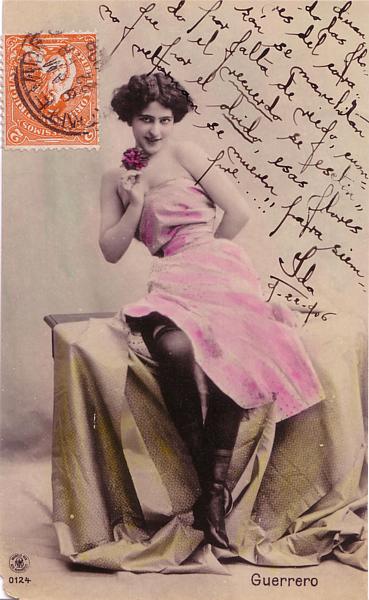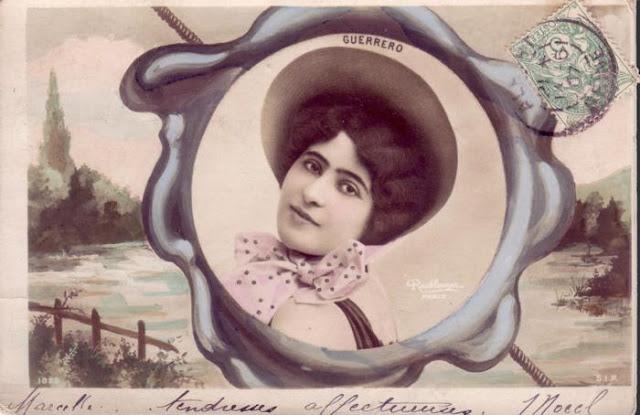This ballet/pantomime version of Carmen premiered at the Alhambra Theatre in London in 1903 with choreography by Lucia Cormani and music by Georges Bizet (and supplemented by George W. Byng). It was condensed to five scene and about 45 minutes. Florenz Ziegfeld brought it to The New York Roof (in New York, NY) in 1904. These notices are mostly from the New York Roof version.
(Photo of Guerrero as "Carmen" at the Alhambra Theatre, London, from Mark Edward Perugini's The Art of Ballet 1915. Photo by Hana, 1903.)
“[Emma] Calvé has said that Guerrero's
Carmen is the greatest performance of the Spanish gypsy girl that has ever been seen. Although this particular
Carmen is all in pantomime, it is one of the finest pieces of acting that has ever been produced in this country.”
(New York Roof Garden production of Carmen )
This young Spanish pantomimist dancer recently seen in “The Red Feather” will be starred here shortly in an elaborate production of “Carmen”, a novel feature of which will be a realistic Spanish bullfight with live bulls and horses.
( The Theatre Magazine, March 1904)
The New York roof has been enjoying unwonted patronage, thanks to Senorita Guerrero, who acts “Carmen” in pantomime, supported by a company of seventy-five people costumed with grand opera picturesqueness. This is worth seeing, for it is a novelty here, although of long established popularity in Europe. Bizet's entire opera, with all its characters and varied scenes, and the principal musical numbers played in continuity by the orchestra, is compressed into less than forty minutes' time. Not a word is spoken or sung, yet the story of Carmen and Don José and Escamilla [sic] is told in action so poignant that a child might follow it. La Guerrero, who plays the vivid heroine, is an inspiring figure. She is a typical Sevillana, young, spirited, and pretty enough to make the customary prefix of “Belle” superfluous to her name. When she dances you would ask that she do nothing else.
Her pantomime work, too, reveals the accomplished actress, an artiste of rare temperamental gifts. With her are associated Messr. Volpert and Desaure, who furnish highly satisfactory support. The pantomime opera is a lesson in dramatic expression well worth studying. Besides “The Rose and the Dagger”, “La Gitana” and “Carmen” already presented, Senorita Guerrero has in reserve other interesting pieces, including a three-act tragedy by the author of “L'Enfant Prodigue”.
( The Theatre Magazine , August 1904)
[ Carmen ] was finely produced, notable for the strength of the cast. . . and above all for the superb acting of Señora Guerrero as Carmen, and of a M. Volbert as Don José.
Apart from Guerrero's fine presence, her magnificent dancing, the breadth, realism and intensity of her acting throughout, all of which one could never forget, there were two particularly memorable moments in the production: one was the fortune-telling scene, the other — the scene in which Carmen, flirting with the Lieutenant of the Gendarmes in order to lure him away from the gipsy camp, is dividing her attention between her flirtation and the knowledge that Don José has only just been frustrated in stabbing her, while so engaged, by the sudden intervention of her comrades, who are endeavoring to drag him away silently so that the Lieutenant who is just in front shall not hear and so discover the presence of the gipsy band.
In the card scene, Guerrero gave in all its fullness the sense of a tragic, overhanging doom. In the other, all the combined cunning and fighting instinct of a savage animal at bay with circumstance, and trying by sheer cunning and audacity to master it, came out, and it was not acting but reality, the real Carmen of Merimée extricating herself and her comrades from discovery and disaster in the use of her dazzling, unconscionable charm.
( A Pageant of the Dance and Ballet by Mark Edward Perugini, 1946; reprinted from Perugini's 1915 The Art of Ballet )
Bizet’s opera Carmen has inspired several ballets, including Roland Petit’s successful version, first given in London in February, 1949 and in July of last year, José Greco’s presentation in terms of Spanish Dance—probably the most ambitious true Spanish bellet yet produced. But neither Petit’s nor Greco’s version was the first Carmen ballet, for in 1903 the Alhambra Theatre, Leicester Square, gave a five-scene version, with Bizet’s music and additional numbers—Cigarette Dance, Hungarian Dance, Students’ Dance, Bolero and Grande Valse—by George W. Byng, and choreographed by Mme. Cormani. The title-role was played by Señorita Guerrero, the only Spaniard in the cast; M. Volbert portrayed the character of Don José with great intensity of facial expression, if one is to judge from contemporary photographs; while the role of the matador Escamillo was cinfided to a woman, Edith Slack. . .
Mark E. Perugini has left a vivid impression of Guerrero as Carmen. ‘Apart from Guerrero's fine presence, her magnificent dancing, the breadth, realism and intensity of her acting throughout, all of which one could never forget,’ he wrote, ‘there were two particularly memorable moments in the production: one was the fortune-telling scene, the other — the scene in which Carmen, flirting with the Lieutenant of the Gendarmes in order to lure him away from the gipsy camp, is dividing her attention between her flirtation and the knowledge that Don José has only just been frustrated in stabbing her, while so engaged, by the sudden intervention of her comrades, who are endeavoring to drag him away silently so that the Lieutenant who is just in front shall not hear and so discover the presence of the gipsy band.
In the card scene, Guerrero gave in all its fullness the sense of a tragic, overhanging doom. In the other, all the combined cunning and fighting instinct of a savage animal at bay with circumstance, and trying by sheer cunning and audacity to master it, came out, and it was not acting but reality, the real Carmen of Merimée extricating herself and her comrades from discovery and disaster in the use of her dazzling, unconscionable charm.’*
*DancingTimes, September 1912
(“‘Carmen’ at the Alhambra” by Ivor Guest Ballet magazine, Vol 12 No 7, July 1952)



















































